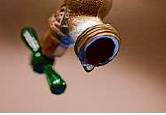Water rates to soar despite full reservoirs
Suppliers cite needed upgrades, efforts to cut fire risks, inflation
By Kurtis Alexander
All that rain and snow captured in California’s reservoirs this year means plenty of water to go around. But it isn’t doing anything to reduce your household water bill.
The Bay Area’s largest water suppliers, including the San Francisco Public Utilities Commission and the East Bay Municipal Utility District, are planning new rate hikes for water and sewer service, starting this summer. Many of these increases will be the biggest in years.
San Francisco residents can expect to see an average 8.3% annual jump in their combined water-sewer bill over the next three years, or a cumulative 27% increase. EBMUD customers can anticipate an 8.5% increase in each of the next two years, or a roughly 18% total hike. Actual bills depend on the amount of water consumed.
“We get this question a lot: Why raise rates if we have this abundance of water?” said Christopher Tritto, a spokesman for EBMUD. “Well, what we’re really paying for is all of the infrastructure to store the water, to transport it to the Bay Area and to distribute it. … The water we get from the rain and snow is essentially free.”
The past winter brought record wet weather to parts of the state, ending a three-year drought and leaving most major water agencies with brimming reservoirs.
Both EBMUD, which serves much of Contra Costa and Alameda counties, and the SFPUC, alongside other utilities planning new rate hikes, intend to spend the bulk of their additional revenue on capital improvements. The work ranges from ho-hum upkeep of infrastructure, including replacing hundreds of miles of pipelines and upgrading treatment plants, to more novel endeavors, such as developing rain gardens and potentially desalination.
“EBMUD turns 100 years old on May 22 and is entering the most capital-intensive period in its history,” said Tritto, noting plans for $2.8 billion worth of projects over the next five years to maintain a system that brings Sierra Nevada water to such cities as Oakland and Berkeley.
Water managers across the Bay Area say that climate change poses an additional — and costly — challenge for suppliers. Extreme swings from droughts to deluges, for example, have many agencies working to add storage capacity and flood protection.
The Marin Municipal Water District this week approved a rate increase for July 1, hiking bills an average 23% for a single-family customer, that will, in part, fund efforts to reduce wildfire risk on watershed lands. The agency leans heavily on a few streams and reservoirs on Mount Tamalpais, an area that has become increasingly vulnerable to fire with the warming climate. The district’s plan includes trimming combustible vegetation and improving fire roads.
Marin Water’s rate hikes are among the biggest in the Bay Area and, over a four year-period, mean a cumulative 58% increase on the average bill for a single-family customer. Rate hikes in the district have averaged 4% annually over the past three decades. The agency serves about 191,000 people.
San Jose Water, which supplies a little more than 1 million people in the South Bay, also expects to increase rates this summer, though details haven’t been finalized. The agency is figuring out how to handle a recently announced 14.5% bump in its water costs from the wholesaler Santa Clara Valley Water District.
The Contra Costa Water District, directly supplying about 205,000 people, will consider rate hikes in the fall.
The Alameda County Water District, in February, approved new 4% rate increases for its service area of about 350,000 people, covering Fremont, Newark and Union City.
Water agencies cite high inflation as an additional driver behind the increases.
Also, the utilities expect to see less water purchased in coming years, and hence less revenue, because the conservation practices that customers embraced during the drought are not likely to go away quickly, if at all. This was the case after the 2012-2016 drought.
The SFPUC, which directly serves nearly 900,000 people in San Francisco, is scheduled to vote on its higher water and sewer rates Tuesday. Under the proposal, both the fixed base rate and the amount charged for the volume of water used, or discharged in the case of wastewater, will rise, resulting in an average 8.3% annual increase over three years for single-family households.
The average bill for water and sewer after the first adjustment would be $149 a month, according to the SFPUC. The new rates would kick in July 1.
“Even with these proposed rate increases, our services are a tremendous value,” said John Coté, spokesman for the SFPUC. “One gallon of our world-class tap water would cost only 2 cents, while a gallon of bottled water costs $1.79 on average. Our services are also competitive with our peers.”
The agency did not raise rates last year. Over the previous four years, rates rose an average of 8% annually.
EBMUD, which serves about 1.4 million people, is scheduled to vote on its increases June 13. Under the agency’s proposal, both the fixed base rate and the volumetric charge for water would rise 8.5% this July and again next July.
The average monthly bill for water, not including wastewater service, would be about $80 a month after the first increase, according to the district. Sewer service, for the portion of EBMUD customers that get it from the agency, would average about $27 a month.
The district raised rates 4% in each of the past two years.
If there’s any consolation, water managers say, most utilities recently dropped their drought surcharges — the extra charge added to make up for revenue losses during the drought.
At EBMUD, the surcharge was 8%. At SFPUC, it was 5%.
Reach Kurtis Alexander: kalexander@sfchronicle.com

